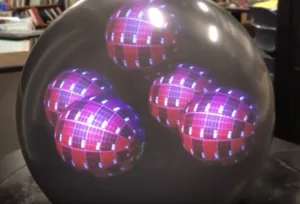In my recent articles I discussed the status of AR/VR as well as some non-consumer applications for AR/VR Hardware. So far my enthusiastic view of these new technologies has be dampened by limitations in the performance of existing devices.

While new hardware is coming out on a regular basis (like the Microsoft HoloLens 2 or the Varjo VR-1 for example), until now all new devices have not swayed the consumer interest in any significant way. So far the interest is considerably larger in professional applications compared to the consumer interest.
The latest display technology that offers such applications an alternative display option is the spherical display system as developed by the University of British Columbia in cooperation with the University of Saskatchewan. While this technology has been around for a few years, the latest version allows more than one viewer to see a computer generated image within the sphere. According to the inventors, the new spherical display called Crystal is capable of providing two users with the means to complete cooperative tasks, video conferencing, virtual learning or play games for that matter. All of this with the correct 3D perspective from every angle.
 Crystal 3DPS Display; credit University British Columbia
Crystal 3DPS Display; credit University British Columbia
The system consists of a 600mm (24inches) hollow plastic sphere that is used as a projection screen of some sorts. The system is completed by using four high speed short throw projectors and a camera. While the sphere is obviously custom-made, the projectors and the camera are off-the-shelf items. The next system may enable four people to interact simultaneously. This implementation is basically a rear projection system with blended projectors illuminating the inside of a spherical surface.
A typical use of such a system is in the educational field to create a model of the earth. Indeed one of the earlier demonstrations does exactly that. This idea is not new and has been around for many years. Over time, the system developed in performance and varied in the number of projectors used in the system. The group around Professor Sid Fels from British Columbia University had used up to eight pico projectors in the display system in an earlier implementation. Besides basically projecting a globe onto the inner surface, the system is also acting as a 3D display as shown below. There is a video of an earlier version available on Youtube.
Crystal 3DPS Display 3D Effect; credit University British Columbia
The group calls this a 3D perspective corrected spherical display. To be clear this is not a volumetric display as the every light emitting point lies on the inner surface of the hollow sphere. In order to create the correct perspective for every viewer the system has to calculate the correct image based on the position of the viewer. The camera provides the means to identify the exact position of the viewer in the space around the sphere. Since the display is spherical, the user can walk around and watch the back of any projected object. This makes it clear that content capture is not an easy thing and more likely this set up will work with computer generated content.
Considering the layout of the sphere and the projectors the resulting pixel density should be around 40 ppi at the ‘equator’, not exactly a high resolution display by any means but considering the viewing distance of a few feet, more than adequate.
They are using fast DMD based projectors together with 3D glasses to show every user their own perspective. Even with the fast switching of the DMD imager there is a limit to how many people can be watching at the same time. The refresh rate goes down as more people join the scene. The use of 3D glasses does raise the question of user friendliness and acceptance in a consumer environment. So far the use of 3D glasses anywhere outside of a movie theater has been not very successful.
 Crystal 3DPS Display 3D glasses; credit University British Columbia
Crystal 3DPS Display 3D glasses; credit University British Columbia
As I mentioned before, this group has shown this technology before and continues working on it. So how does this system suddenly become a contender in the virtual reality world? There are two aspects that need to be looked at. First of all, using the term ‘virtual reality’ with any new university based technology attracts a certain amount of interest in the venture capital world. VC projects supporting the further development of university research contributes to the financing of the university and is as such very important.
The second aspect is the ability of the system to accommodate more than one user viewing a perspectively correct 3D image. There are uses in the professional field that may create a good value proposition for such a system. The developers themselves are seeing this system as special display for collaborative applications like VR aided learning, joint meetings of users, virtual surgery and multiplayer VR games. The focus for now is on teleconferencing and computer aided design. I would agree that based on the relatively complex nature of the system the overall pricing will limit its use to applications that benefit the most from such a set-up.
The term VR suggests an immersive environment, with the Crystal display being pretty much the opposite. Instead of tricking your brain into believing that you are part of the environment, you are more of an observer looking into the displayed world. This makes the user an observer, not a participant. So far Crystal is still more or less a university project and we have to see if it can develop into a real world product. -NH

